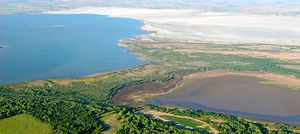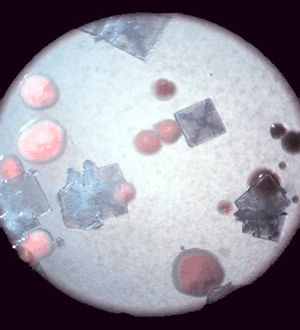Salt Plains (Oklahoma): Difference between revisions
| Line 25: | Line 25: | ||
===Halophiles in Hypersaline Environments=== | ===Halophiles in Hypersaline Environments=== | ||
These microbes have to overcome high salt environments, overcome intense UV, and avoid desiccation (the state of extreme dryness or the process of extreme drying). | These microbes have to overcome high salt environments, overcome intense UV, and avoid desiccation (the state of extreme dryness or the process of extreme drying). | ||
====Overcoming high salt==== | |||
To prevent water loss, the halophiles accumulate solutes in their cytoplasm. They use Na+ pump to push Na out of the cell as well as keeping a concentration of K+ ions (about 5M) to balance out the osmotic pressure. | |||
[[#References |[5]]] | |||
====Intense UV==== | |||
Halophiles have very efficient DNA repair to survive the UV. They use their pinkish pigment to help photoprotect themselves. There is also Bacteriorhodopsin, which is a purple proton pump that drives ATP synthesis. | |||
[[#References |[5]]] | |||
====Desiccation==== | |||
The state of extreme dryness or the process of extreme drying. As crystals grow, small amounts of brine are trapped within the crystals as well as the halophilic Archaea. | |||
[[#References |[5]]] | |||
===Isolated Archaea=== | ===Isolated Archaea=== | ||
Revision as of 22:47, 8 April 2013
Introduction
In the introduction, briefly describe the habitat that is the topic of this page. Introduce the habitat, its ecological significance, and the importance of microorganisms in this environment. (What processes do they carry out? What functions do they perform?)
The Great Salt Plains is an 840-acre Oklahoma state park located in Alfalfa County, Oklahoma. This area is a natural hyper-saline environment. Permian brine comes up from deep in the plains to the surface where it evaporates. Scientists believe that salt was deposited during repeated water-level rises of a shallow sea millions of years ago. The supply of salt is kept intact by saline groundwater that flows just a few feet below the surface. When the water evaporates, a layer of salt remains on the surface. This process also plays a role in the formation of selenite crystals that visitors covet [1]. When the rains arrive, they dissolve the top layer of salt creating small waterways and pools of water. These small areas of water change the concentration of salt very quickly from low to high concentrations. With a huge expanse of no vegetation, there is no shade/protection from the sun's ultra violet rays. Over a typical 24-hour day the average temperature range around 30°C. The combination of the salinity, temperature, and UV makes this an extreme environment. This environment contains Halophiles which are photoheterotrophs, using light for energy and methane as a carbon source. They can be in either aerobic or anaerobic conditions. [2]
Environment
Physical
This 7x3 mile land is known for Selenite crystals. It is made up of mud and is covered in a thin layer of salt from a sea millions of years ago. A few feet under the plains, there is saline ground water running that periodically floods up onto the surface in small pool after it rains. The process of evaporating starts again.
Chemical
The adjacent lake has a salinity of 50% that of sea water. The Selenite is gypsum, chemically hydrous calcium sulfate. The gypsum and saline solutions in the soil promote crystal growth especially when the temperatures are in ideal conditions. During times of high rainfall, the Selenite will dissolve back into solution until conditions return.
Microbial communities
Halophiles in Hypersaline Environments
These microbes have to overcome high salt environments, overcome intense UV, and avoid desiccation (the state of extreme dryness or the process of extreme drying).
Overcoming high salt
To prevent water loss, the halophiles accumulate solutes in their cytoplasm. They use Na+ pump to push Na out of the cell as well as keeping a concentration of K+ ions (about 5M) to balance out the osmotic pressure. [5]
Intense UV
Halophiles have very efficient DNA repair to survive the UV. They use their pinkish pigment to help photoprotect themselves. There is also Bacteriorhodopsin, which is a purple proton pump that drives ATP synthesis. [5]
Desiccation
The state of extreme dryness or the process of extreme drying. As crystals grow, small amounts of brine are trapped within the crystals as well as the halophilic Archaea. [5]
Isolated Archaea
Current research finds archaea isolates phylogenetically related to Haloarcula, Haloferax, Halorubrum, Haloterrigena, and Natrinema. [3]
Characteristics of Halophilic Archaea
"Halophilic Archaea (whose name comes from Greek for "salt-loving") thrive even in concentration of salt five times greater than the salt concentration of the ocean and in salt concentrations higher than those used in any food pickling processes. They in fact require salt for growth and they are adapted to environments which have little or no oxygen available for respiration. Instead, their cellular machinery contains charged amino acids on their surfaces, which react to the salt." [4]
Specific Microbes
- Acidovorax delafieldii
- Pseudomonas sp
- Halobacillus salinus
- Bacillus simplex
[4]
Microbial processes
What microbial processes define this environment? Describe microbial processes that are important in this habitat, adding sections/subsections as needed. Look at other topics in MicrobeWiki. Are some of these processes already described? Create links where relevant.
Current Research
Response of Photosynthetic Microbes of the Salt Plains National Wildlife Refuge to Dynamic Extreme Conditions
"Few studies have addressed multiple variable stress factors likely to be even more adverse to life. Evaporitic salt flats, such as at the Salt Plains National Wildlife Refuge in Oklahoma, represent such a dynamically stressful habitat: direct sunlight, up to 20-30° C diel (60-70° C annual) surface temperature range, episodically varying interstitial and surface pool salinities from near 0 to over 300 g/L, and potentially wide diel fluctuation in pH, redox potential, and dissolved gases and nutrients. Thus, the mostly undescribed photosynthetic and heterotrophic microbes in this habitat may provide unique insights into the evolution of life beyond the limits of tolerance for virtually all species on Earth. The proposed general hypothesis is that interacting stress factors determine survival, productivity and competitive outcomes in hypersaline photoautotrophs, and that halophiles are tolerant of wide fluctuations in physiocochemical conditions in addition to steady-state extreme conditions."[6]
Colorimetric microbial diversity analysis and halotolerance along a soil salinity gradient at the Great Salt Plains of Oklahoma
"Microbial diversity was measured along a salinity gradient at the Great Salt Plains of Oklahoma using colony color quantified as RGB components of microbial isolate streaks. Surface soil samples along a 6-m salinity gradient (from hypersaline soil with 7.5% salinity to oligohaline rangeland soil) at WP68 were dilution-plated on SP medium of various salinities and hundreds of random colonies were collected. These results are complementary to previous molecular genetic analyses of 16S rRNA clone libraries from soils at the Great Salt Plains. Great diversity at lower taxonomic levels supports the suggestion that gene flow is not highly fragmented, a result of less specialization, as expected given the highly variable salinity observed at the salt flats with rain events." [7]
Military
References
-[1] | John W. Morris, Charles R. Goins, and Edwin C. McReynolds, Historical Atlas of Oklahoma (Norman: University of Oklahoma Press, 1986).
-[2] | Santos, H., and da Costa, M.S. (2002) Compatible solutes of organisms that live in hot saline environments. Environmental Microbiology 4: 501-509.
-[3] | Caton, T. M.; Caton, I. R.; Witte, L. R.; Schneegurt, M. A., Archaeal Diversity at the Great Salt Plains of Oklahoma Described by Cultivation and Molecular Analyses, Microbial Ecology;Oct2009, Vol. 58 Issue 3, p519
-[4] | Kushner, D.J. (1993) Growth and nutrition of halophilic bacteria. In: The biology of halophilic bacteria (Vreeland, R.H., Hochstein, L.I., Eds.), pp.87–103 CRC press, Inc., Boca Raton, FL.
-[5] | Grant, W. D., eds., Extremophiles: Microbial Life in Extreme Environments, Wiley-Liss, Inc. pp 93-132.
-[6] | William J. Henley, Department of Botany, Oklahoma State University
-[7] | Res Microbiol. 2013 Jan;164(1):83-9. doi: 10.1016/j.resmic.2012.10.004. Epub 2012 Oct 12. Department of Biological Sciences, Wichita State University, Wichita, KS 67260, USA.
Fendrihan, S., Legat, A., Pfaffenhuemer, M., Gruber, C., Weidler, G., Gerbl, F., Stan- Lotter H. (2006) Extremely halophilic archaea and the issue of long-term microbial survival. Rev Environ Sci Biotechnol 5, 203-218.
Edited by Brian Chan, a student of Angela Kent at the University of Illinois at Urbana-Champaign.


